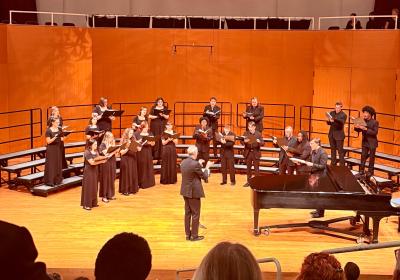
People of CSU: Professor Pedro Gerum was part of a NASA team that discovered 301 planets
Professor Pedro Gerum is part of the Department of Operations and Supply Chain Management at Cleveland State University. His research focuses on supply chain and transportation issues.
Call it a side hustle, but Gerum was also part of a NASA team consisting of 12 scientists that recently discovered 301 planets.
Back in 2019, Gerum was still a student at Rutgers University, working toward his doctorate in Industrial Systems Engineering. That is when he accepted an internship with NASA joining a team of scientists working at the Ames Research Center in Mountain View, California.
Gerum and the Ames NASA team were to work with and introduce ExoMiner, a new neural network that leverages NASA's supercomputer Pleiades to comb through data that the Kepler telescope had gathered in the hopes of finding planets.
Neural networks have been used in the past in a process called deep learning, a machine technique that “teaches” computers by simulating the neural pathways in human brains in an attempt to model human prediction patterns in computers. It is a form of artificial intelligence.
"With deep learning, the idea here is that we are giving the computer data, and you are telling the computer to decide itself, what kind of steps you want it to take," Gerum explained. "You provide the computer with thousands or millions of examples. The computer itself learns what is important."
Gerum said that ExoMiner, the neural network they were working with, used a similar concept. Scientists use the brightness of objects as one way to determine if the target star has an orbiting planet.
The Kepler telescope takes video and imagery over a long period of time focusing on certain areas of our universe. A star's brightness will be constant with no change over time. A dip in brightness could have happened if something crossed the path of Kepler.
"This dip in light could mean many different things. It could be a comet, noise in the data, faulty sensor in the telescope," Gerum said. "We tell the computer, I don't know which dips in brightness were caused by planet crossings. What I know is that those thousands of light curves, those thousands of stars. They have planets; you figure out what is causing the dip. I will provide you with new stars; you tell me if they have a planet."
When ExoMiner is combing all the data to figure out what is a planet or a false positive. It is not 100% accurate, as this is the case for most algorithms in deep learning. Gerum and the NASA team determined that ExoMiner is more accurate and reliable than other neural network classifiers. Per their study, ExoMiner retrieved 93.6% of all planets in a data set compared to the rate of 76.3% for the previous best neural network classifier.
Gerum explained that they are not writing a recipe for the computer. They are just guiding it by making minor tweaks to make it more accurate and reliable. They are validating the information ExoMiner is telling them to make sure it is going in the right direction.
After they were confident that ExoMiner had found data for planets. The team that Gerum was working with handed the data over to a group of astronomers to verify it.
When they were finished the astronomers confirmed that the team had found 301 exoplanets, adding to a growing list of almost 5,000 verified planets.
Gerum sees ExoMiner as a game-changer for astronomy and how planets are found. He said it not only cuts down on time to verify the planets, it is designed to work with any telescope, with only minor tweaks, unlike previous neural networks.
"Instead of waiting months or even years where telescopes are looking if they have planets. We can really speed up this process," Gerum explained. "We are finding more planets more accurately, and we are confident that we do not have to rebuild the wheel every time."
Each new telescope will bring new data for ExoMiner to work with. An example, of this, is because ExoMiner was fitted to work with the Transiting Exoplanet Survey Satellite (TESS), in the hopes of discovering more planets.
Gerum went on to explain how proud he was to work with this team and NASA that discovered 301 new planets.
"It's a team effort. I didn't do everything. I did a small part. Twelve scientists working on it, very brilliant scientists. I'm very excited to be a part of this," Gerum said. "It's very fulfilling to see the pinnacle of the whole thing. I'm very appreciative of the whole thing."
Helping discover planets is not the only thing Gerum has researched. For example, Gerum's thesis at Rutgers focused on ways to improve railroad track inspections. His research at Cleveland State is on supply chain and transportation issues.
At the core of Gerum's research is data science. Data science can be applied to numerous fields across the world. It's a subject the Gerum is passionate about.
"Data sciences has so many applications everywhere. I think that using data science to leverage transportation to make it better has a really tangible impact on people's lives," Gerum said. "I really like to research on how I can impact people's lives."
Gerum's research on transportation issues is focused on how to predict traffic congestion in rare events. Those rare events could be a flood, a snowstorm, a car crash, or even a wildfire.
"We can use deep learning for this too. We have all the historical data," Gerum said. "We give the computer all this information, and we ask the computer can you tell what the traffic is going to be, 10 minutes from now, 20 minutes from now, an hour from now."
For this research, Gerum is writing proposals seeking funds and grants that will allow him to create a team here at Cleveland State that will work with deep learning. This team would bring in other professors and students to assist in the research.
For now, Gerum is not working on another project for NASA. He wants to focus on his research on transportation issues. However, he does not rule out working with NASA down the road if the opportunity presents itself.




